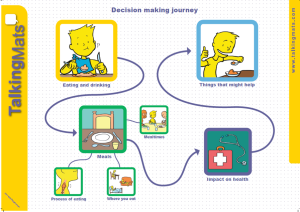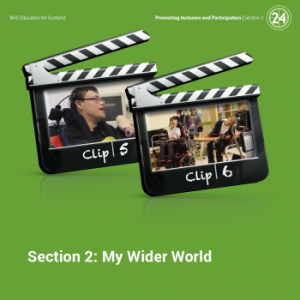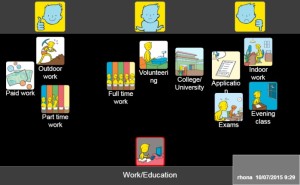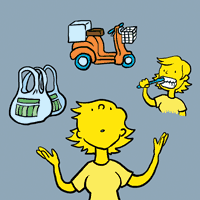The Children and Families Act 2014 makes clear that local authorities in England must have regard to the views, wishes and feelings of the young person and the parents. How do you ensure children and Young People are fully involved in decisions about their support and what they want to achieve? This blog describes how Talking Mats can be used to support the Education and Health Care Plans (EHCP).
A question like ‘What do you want to be able to do in the next 12 months, that you can’t do now ?’ is difficult for us all. For children and young people who struggle with communication, this is even more of a challenge.Talking Mats is an ideal tool to support the young person to consider this big question because it breaks down the dialogue into bite-size chunks, makes abstract concepts more concrete, and creates a visual record of the discussion.
The top scale can change depending on the topic and what the interviewer wants to find out. It can vary from
- things I like/ don’t like/ unsure
- things that are important to me / not important/ not sure,
- things I want to try/ don’t want to try/ not sure .
We have two resources that can be used to support conversations about planning :
- Health and Well being – this resource is based on the WHO ICF framework and allows you to have a topic focused conversation on the various aspects that make up well being
- Consulting Children and Young People this resource gives a much more holistic overview of how the young person or child is feeling about their lives
- Example from Health and Well being resource
Using the work/education topic from the Looking after yourself set in the Health and Well –being resource, this pupil is able to express what his aspirations are post school. Click on picture to enlarge.
- Example from Consulting Children and Young People resource
This example came from a primary teacher and demonstrates how the process of using Talking Mats can help a young person reflect on their lives and in this case make positive change . The teacher told us about a pupil aged 8 who placed the symbol for ‘being listened to’ in the position for something he liked, and the symbol for ‘listening to others’ in the position for something he didn’t like. ‘That’s not right’, he exclaimed.
There was no miracle cure she said. ‘But it was like a light bulb going on!’ He began to engage with work on his interaction and listening skills and ended up a playground champion.
Free Seminar
We are holding a free half day seminar in London on the 20th October. The seminar is an introduction to how you can use Talking Mats to support pupil participation in planning . If you wish to attend please let us know by responding to our invite. We would love to see you. London Seminar Invite
We are delighted to be a Winner in the People Driven Digital Health Awards which were held in Leeds on Friday 3rd July. These awards were instigated to recognise the work of digital health innovators from across the UK and aim to connect the people who have ideas and make them happen.
The event was organised by mHabitat and compered by a well known health commentator, Roy Lilley, of the Academy of Fabulous Stuff. The evening was full of fun and energy and we met lots of interesting people and made good connections. There is loads going on in digital health and services should make use of all these fabulous innovations that will improve people’s lives and health services. To get a flavour of the evening follow #PDDAwards15 and to find out about the other winners click here.
Our category, ‘the most impressive third sector digitally enabled service’ recognises third sector services which have embedded digital tools and services into improving people’s experience and outcomes. We very honoured to win this category with our digital Talking Mat. The announcement of the winners was followed by a flurry on Twitter which you can dip into here .
Background
Social workers are required to complete a detailed assessment of their client’s needs. It is recognised that it can be a challenge to ensure clients fully participate in the process if they have cognitive or communication difficulties. The City of Edinburgh Council were keen to explore if we could adapt their standardized assessment tool and make it into a Talking Mat framework. Several staff in the council are already skilled practitioners in Talking Mats so are familiar with the framework and use Talking Mats in their practice. They are enthusiastic about the benefits of using Talking Mats both in terms of how it increases participation of service users but also because in their view it makes interviews easier for staff to undertake.
Structuring Talking Mats assessment framework
In order to develop the bespoke Talking Mat we held a seminar to discuss the social work assessment tool and approach used. Six key staff attended the seminar, facilitated by two Talking Mats associates. The discussion at the seminar identified a structure that would enable us to construct a coherent visual conversation that would cover the issues required to complete the assessment, using mind mapping to support this process. It is also important to identify a top scale that matches the question you are asking and make sure the options you are including are neutral and not leading.
The structure that emerged from this discussion is a Talking Mat that enables people to explore their views on 3 topics
- their home
- their health and well being
- their community involvement
Trialling the Talking Mats framework
Talking Mats then took the mind maps and developed these into symbol sets that were piloted by social work staff. At the end of the pilot a review was held and changes made which included alterations to
- the language used
- the symbols used
- the topic an option was included under
- making it clearer to staff when options were more abstract and required further explanation and or personalisation
Nicki Ewing from Edinburgh City Council who leads on the project says ‘ I am very excited that staff have a tool that can make assessment more meaningful for service users to participate in and makes it easier for staff to get good quality information’.
Next steps
We are thinking of holding a focus group for others that might be interested in using the framework for their practice if, you are interested please contact Lois via the info@talkingmats.com email – call your email ‘social work focus group’.
We were recently involved in a discussion about the merits of symbols versus photographs to support communication, a topic which we have spent some time considering over the past few years.
We have also found an excellent small book titled ‘Too late to drive’ by Helen J Bate and published by Pictures to Share C.I.C. In it Helen discusses the meaning of pictures and visual perception in relation to dementia. There are some excellent quotes such as ‘Recognition is not the same as relevance, and relevance is what is important to us when we have dementia’ and ‘The images that really talk to people are produced with a skill and an understanding of the visual image as a method of unspoken communication’..
Our gut feeling is that for many people who use Talking Mats (who we refer to as ‘thinkers’), symbols may be more helpful than photographs and, although we have not carried out any academic research, we have lots of anecdotal evidence from a number of practitioners about some of the pitfalls of using photos. Here are a few:
- The ‘thinker’ tends to get caught up in the detail of a photo e.g. Australian colleagues told us about using photos of different rooms in a day centre but the ‘service users’ got caught up with seeing specific details in the photos rather than considering the over place
- Sometimes a photo can be too specific e.g. we were told of a person with dementia who was shown a photo of cornflakes to represent breakfast but could only focus on the cornflakes
- The ‘thinker’ may be distracted by a photo of a real object e.g a person with learning disability fixed on the make of a particular car instead of considering transport
- We are always wary of using photos of real people as it may be too sensitive for the ‘thinker’ – symbols appear to reduce the emotion impact of the image and be easier for people to comment on
- If the person in the photo has changed, for example their hairstyle or glasses, this can confuse the ‘thinker’
- If the ‘thinker’ has been involved in the place or event in the photo this can affect their views whereas a symbol is more neutral
- Sometimes the clarity and quality of home taken photos can be poor.
- Commercial photos like Photosymbols are good quality but we are aware that they tend to be used repeatedly, sometimes for quite different meanings
Here is a link to a previous blog which gives some additional information about the development of the Talking Mats symbols.
Academic research evidence on visual images and communication is limited and Helen suggests that that ‘If the academic world wants to explore or challenge anything [in these pages] then at least the conversation has begun’. We would welcome any further information, references or comments.
Please send them to info@talkingmats.com
Many thanks to Sara Toyn, Head of Adult Speech and Language Therapy, who has given us her thoughts on an organisational Talking Mats training course recently held in Powys, Wales. Together with Katie Earing, Sara organised the training course which included participants from a variety of NHS backgrounds and who worked with a range of adults with communication difficulties.
‘I attended a Talking Mats training organised by our team and offered to trained and untrained members of staff working in hospital and community. As an SLT I found it good revision and review of my own practice and also helped refocus some of my ideas and approaches.
The evaluations from all participants were extremely positive. We were overcrammed into too small a room as is the case with many training rooms and usually this is the first comment made on feedback. I think it is positive that no one mentioned this at all on the evaluations as everyone was very engrossed in the activities and videos. I have had several individuals point out how much they learnt and they report an increase in confidence in communicating with clients.’
Here are some of the comments from course participants
- This has opened up a whole new world of communication. Thank you.
- Very worthwhile course, have learned a lot and will surely use the mats at work.
- Feel I could integrate this into everyday practice with stroke patients – goal setting, D/C planning etc.
- Good interactive session.
- Completely unique! Thank you.
- Thank you. Excellent training, very transferable skills and will benefit patients.
- Really good. Being specific in the topic and phrasing questions openly, not only using Talking Mats.
- Have a patient in mind for tomorrow morning.
- Thank you. Really useful WHO ICF framework and framework for thinking about people’s cognitive level.
For further information about the training we offer, please click here
Thanks to Karen Wilson, a specialist teacher and one of our accredited trainers, who describes how Talking Mats can help in supporting Looked After Children in having their say.
‘I work as Principal Teacher for children with additional support needs in a mainstream secondary school. In supporting a wide range of children and young people, I am frequently involved in Looked After Children reviews. These reviews can be quite daunting for an adult, as all agencies involved with the young person are represented, along with their carers and their support agencies. I can’t imagine what it must feel like as the child.
Many of these young people find it difficult to express their views, partly because of the circumstances they find themselves in and partly because many of them have communication difficulties linked to their early experiences. I have been struck by how little information is often contained in their Having Your Say form. This should be one of the key ways for young people to express their views and is completed in advance of the review.
I recently used a Talking Mat to help a young person complete her ‘Having Your Say’ form. The young person reported that it was much easier to engage in the process and told me that she had enjoyed doing it. She normally does not like filling in the form. All of those involved in the review expressed surprise and delight at how much more information it was possible to get using a Talking Mat.
I am now working with Talking Mats to explore how this idea can be developed to give more of our Looked After young people a stronger voice in decisions which directly affect them.’
Have a look at the following blogs for further information on theTalking Mats GIRFEC resource and how it is being used
We are delighted to announce the release of Version 2 of the Talking Mats App
This app has a number of great new features which many of you have been asking for.
There are two new resources – Eating and Drinking – which has 3 main topic sets – Meals, Impact on Health and Things that might help.

There is an amazing new feature which many people have been asking for. Version 2 allows you to add your own images from your camera roll. This means that you can add you own personalised pictures to any of the topics.
Watch out for next week’s blog when Lois will tell you about her holiday using this new feature!
You can now also reset your password, use the Back button to navigate through the app, delete individual sessions and use the updated report page.
If you have already purchased the gold version of the Talking Mats app you will get all these new features for free.
If you wish to purchase the app please click here or for further information call our office 01786 479511
As part of the Right to Speak initiative Talking Mats was funded to develop ‘Promoting Inclusion and Participation’: an online learning resource for staff working with children and young people who use Alternative Augmentative Communication (AAC). We have been delighted to work with NHS Education Scotland on developing this free resource and also have really enjoyed working in partnership with the learning and development consultancy: Forum Interactive.
The complexity of care for children and young people who use Alternative and Augmentative Communication (AAC) is multifaceted. Ensuring that goals are centred on the young person and family’s needs is a constant challenge to practitioners. There are several resources that focus on developing the technical skills of developing AAC but there is a scarcity of resources that focus on the impact of AAC on the child’s day to day life.
Promoting Inclusion and Participation is based on an earlier project which determined the key indicators of a quality AAC service from the perspective of AAC users and their families.
Promoting Inclusion and Participation uses the following frameworks to help practitioners structure their decision making:
- International Classification of Functioning, Disability and Health – Children and Young People (ICF-CY)
- Janice Light’s Communicative Competencies (2014)
- GIRFEC (Getting It Right For Every Child) wellbeing indicators

This on-line resource will help practitioners:
- Understand the role that collaboration and involvement play in delivering wellbeing outcomes for children who use AAC.
- Apply a holistic approach and outcomes focused approach to assessment, implementation and review which places the child at the centre.
- Recognise that as the child develops and changes, so the level of different team member’s involvement will ebb and flow.
Download the resource here. It takes a little time to download so be patient !
We would be delighted to receive feedback of how it is being used.
Ref
Light J , Mcnaughton D, Communicative Competence for Individuals who require Augmentative and Alternative Communication: A New Definition for a New Era of Communication? Augmentative and Alternative Communication, 2014; 30(1): 1–18
Talking Mats is delighted to support Fair Trade through the purchase of new style bags which has come about through the initiative of one of our team, Margo Mackay. She has written the following blog:
The arrival of seven large boxes shipped from Kolkata caused great excitement in the Talking Mats office last week. For me personally opening up the boxes from the Freeset factory immediately brought a series of images to mind. Just over one year ago, at the start of 2014, I was part of a delegation of Scottish women who visited India to see businesses set up to help women who had been trafficked.
A tour around the factory revealed well organised systems with women busy working in production; cutting, sewing and printing bags ordered from all over the world. A factory like any other but with a significant difference. Most of the employees had previously been trapped in India’s sex trade which had robbed them of dignity. For them, getting a job in the Freeset factory gives the women a chance to regain control of their lives in a caring community.
They are given fair pay and conditions, offered education and health care. They are supported to make their journey out of prostitution and into a new way of living, restoring hope. Although a business, Freeset is also a community. The women are often dealing with health problems (including HIV/AIDS), and psychological effects from abuse and exclusion from society. This makes for a challenging workplace and much effort is put into creating a compassionate environment where the women are supported and their needs met.
As a Social Enterprise business, through selling our Talking Mats products, we are now participating in a woman’s journey to freedom. The transformation in women’s lives is clearly apparent, simply because they’ve been given a chance. We are proud to be supporting this enterprise.
Why don’t you have a look for yourself on their website? http://freesetglobal.com/
And why don’t you treat yourself to one of these attractive bags by buying one of our products
Talking Mats is delighted to announce that we have developed our own doggy Talking Mat to allow us to find out the views of our canine friends . Sally has been busy working on this as her swan song to Talking Mats . Sally has always been passionate about ensuring that pets are fully included in every Talking Mat. The Talking Mat for your dog launches on the 1st of April the day she starts her new job.
Good Luck to Sally in her new role as Head of Education , Research and Practice at Strathcarron Hospice -we know you will be as fab there as you have been here!
NB No dogs were harmed in the production of this resource.
 Online training login
Online training login 





